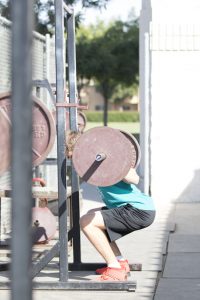The Isolation Problem: Reasons to Use Compound Barbell Movements Instead of Machines
Many if not most gym-goers, especially those who are members of the typical commercial exercise gym/club, engage in resistance based exercise using isolation exercises primarily or exclusively. They go from machine to machine in a circuit, doing one or more sets of many different isolation movements.
If their goal is just to exercise (that is, do physical activity which produces a transient physiological response which does not necessarily contribute to long term improvement–see blog post #2) and pursue general physical well-being, that approach is fine. It cannot, however, induce meaningful transformation in strength for a couple of reasons.

First, this approach is terribly inefficient. The time investment necessary to produce enough stress to drive significant and ongoing strength increase provides woefully inadequate returns. To match the actual quantity and quality of stress achieved in a 3 lifts per session, 3 sets per lift barbell workout, a person would need to spend three to four times as long in the gym.
Each machine movement is capable of producing only a fraction of the stress of a single complex barbell movement; multiple sets of multiple exercises for multiple body segments will be required to achieve anything close to a comparable stress.
To approximate the total number of muscles involved in a squat workout, a lifter would need to perform multiple sets of knee extensions, hamstring curls, glute-ham raises (or lumbar extensions), hip abductor-adductor machines, calf raises, abdominal crunches and isometric scapular retractions. That is seven different movements to account for one.
If we look at the numbers associated with the comparison described above we will see the second problem very clearly. Let us assume that the squat will be performed at near maximum effort for 3 sets of 5 reps, a total training volume of 15 reps. If the lifter rests 4-6 minutes between sets to adequately recover and perform well on each set the time, not counting warm-up sets, is between 8 and 18 minutes.
From start to finish, a squat workout for novice lifters should take about 20 minutes. Applying the same framework to the group of seven isolation movements produces a training volume of 105 reps and 80+ minutes of workout time. Because of the increased duration and volume of movement involved, the lifter will likely run out of energy and not be able to finish the workout. This is known as fatigue.
The interplay between stress and fatigue is the other main reason why the isolation approach impedes rather than enhances strength development. The body’s response to stress is the main driver for improving strength. The most effective way to apply stress is through intensity, that is the amount of resistance acting against the body in a movement.
Compound exercises such as the four main lifts (squat, overhead press, bench press and deadlift), because they engage the entire body, can be loaded with much more weight, creating greater intensity than any isolation movement can achieve.

For those movements, greatly increased volume (the total number of repetitions performed) is the only way to approximate the stress involved in the compound lifts.
A lifter could perform 5 or more sets of 10-20 repetitions of an isolation movement and create a fair amount of stress but it still will not have the same effect on the skeletal, muscular and nervous systems produced by 3 sets of heavy (75-90% of a maximum capacity lift) squats.
Trying to perform 7 different exercises with enough volume to produce adequate stress will lead to fatigue before all the targeted muscles have been trained. Fatigue will prevent the lifter from exerting enough force to initiate the SRA cycle for the muscles in several of those movements.
As a way of training work capacity in different energy systems, the approach can be effective but it is counterproductive to strength development.
For those individuals who have decided to train for strength, as well as for everyone else, time and energy are precious and finite resources. Compound barbell exercises offer the best way to maximize those resources in training.
The more efficiently a training session can be completed, the more effective the overall program will be and the stronger and more functional, the lifter will become.
To read the latest Blog: Functional Human blog, No.7 – “The Thigh Bone’s Connected To The Hip Bone…”
To read the first blog: Functional Human blog, No.1








Bryce Foshee • Nov 15, 2018 at 9:53 am
Another great blog post!